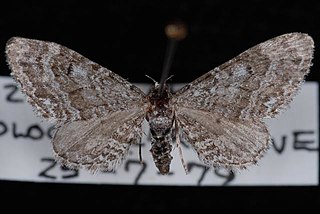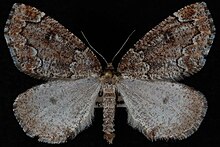
Epirranthis is a genus of moths in the family Geometridae erected by Jacob Hübner in 1823.

Holochroa is a monotypic moth genus in the family Geometridae. Its only species, Holochroa dissociarius, is found in North America. The species was described by George Duryea Hulst in 1887 and he described the genus nine years later in 1896.
Jubarella is a genus of moths in the family Geometridae erected by George Duryea Hulst in 1898.
Scelidacantha is a genus of moths in the family Geometridae first described by George Duryea Hulst in 1896.

Tetracis is a genus of moths in the family Geometridae erected by Achille Guenée in 1858.
Tetracis fuscata is a moth of the family Geometridae first described by George Duryea Hulst in 1898. It is only known from the US states of Colorado and Wyoming.
Tetracis formosa is a moth of the family Geometridae first described by George Duryea Hulst in 1896. It is found in North America from Colorado, eastern Utah and eastern Wyoming west to California and north to southern British Columbia and southern Alberta at elevations between 870 and 2,320 meters.

George Duryea Hulst was an American clergyman, botanist and entomologist.
William Warren was an English entomologist who specialised in Lepidoptera.

Eupithecia borealis is a moth in the family Geometridae first described by George Duryea Hulst in 1898. It is found in North America, including Alberta, Arizona, British Columbia, California, Colorado, Manitoba, Michigan, Montana, New Brunswick, New Mexico, New York, Newfoundland and Labrador, Nova Scotia, Ontario, Quebec, Utah and Wyoming.
Eupithecia sierrae is a moth in the family Geometridae first described by George Duryea Hulst in 1896. It is found in North America, including Colorado, Wyoming, southern Utah, New Mexico, Arizona and California.

Eupithecia nimbicolor is a moth in the family Geometridae first described by George Duryea Hulst in 1896. It is found in North America from eastern Newfoundland and Labrador to western British Columbia and from Alaska to Arizona.
Eupithecia nimbosa is a moth in the family Geometridae first described by George Duryea Hulst in 1896. It is widespread in the Rocky Mountains, from Arizona to the Canada–US border.

Eupithecia multistrigata is a moth in the family Geometridae first described by George Duryea Hulst in 1896. It is widespread in western North America, including the states and provinces of Alberta, Arizona, California, Colorado, Idaho, Montana, Nevada, New Mexico, Oregon, Saskatchewan, Utah, Washington and Wyoming.

Eupithecia perfusca is a moth in the family Geometridae first described by George Duryea Hulst in 1898. It is found in western North America.
Eupithecia subcolorata is a moth in the family Geometridae first described by George Duryea Hulst in 1898. It is found in western North America, from British Columbia south to Arizona and New Mexico.

Eupithecia stellata is a moth in the family Geometridae first described by George Duryea Hulst in 1896. It is found in North America from central Manitoba to northern Alberta and south to California and Mexico.

Eupithecia niveifascia is a moth in the family Geometridae first described by George Duryea Hulst in 1898. It is found in North America from south-western Alberta west to Vancouver Island, north to northern coastal British Columbia and south to New Mexico.
Eupithecia flavigutta is a moth in the family Geometridae first described by George Duryea Hulst in 1896. It is found in the United States in Colorado and montane forest areas in eastern Arizona and south-western New Mexico.
Caberini is a tribe of geometrid moths in the family Geometridae. There are at least 50 described species in Caberini.











